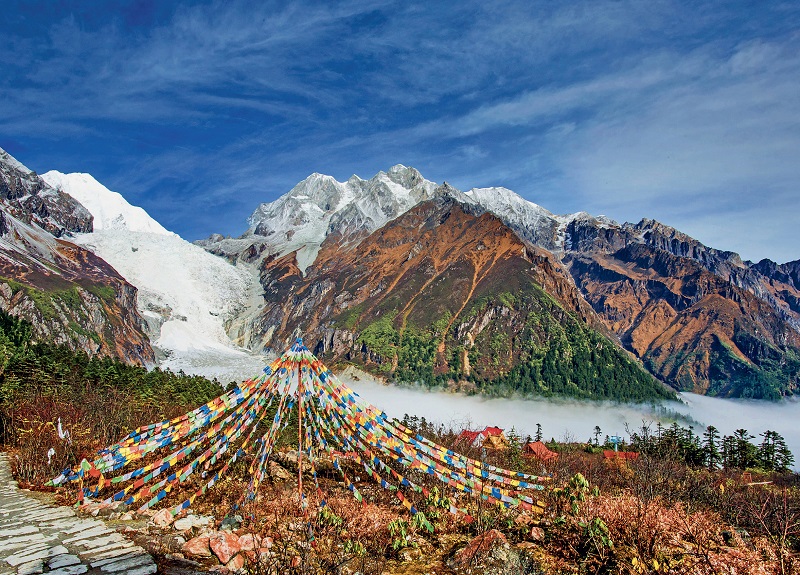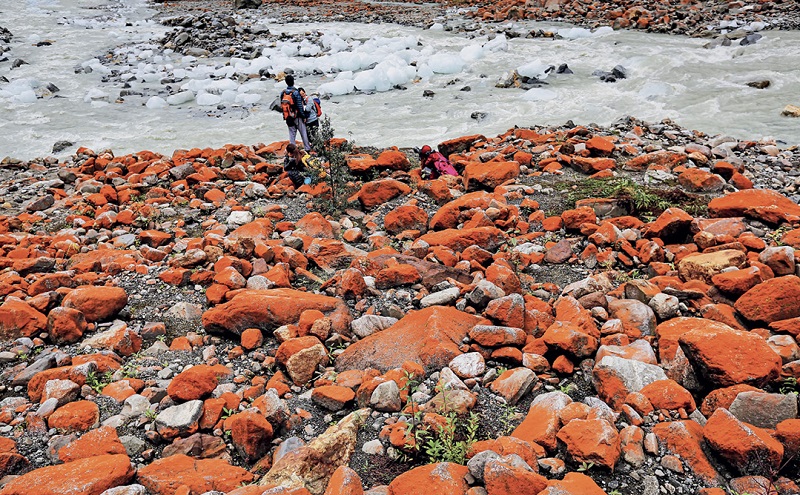Nestled in western Sichuan Province, Hailuogou is known for its low-latitude glaciers, dense ancient forests, and hot springs flowing from the foot of the highest mountain in Sichuan.

A view of the landscape in Hailuogou Scenic Area in Sichuan.
Hailuogou Glacier Forest Park sits on the eastern slope of the famous Mount Gongga, the “King of Sichuan Mountains,” which is located on the southeastern edge of the Qinghai-Tibet Plateau in the southeastern part of Garze Tibetan Autonomous Prefecture of Sichuan Province. It is about 280 kilometers from Chengdu, the capital city of the province. Hailuogou covers an area of 906.13 square kilometers and consists of six scenic areas. With such stunning natural scenery as natural glaciers, alpine peaks, hot springs, primitive forests, and wild flora and fauna, it has garnered the titles of National 5A Tourist Atraction, National Nature Reserve, National Geological Park and National Forest Park, and more than these titles, it is the only Glacier Forest Park in China.

The magnificent view of the golden mountain shining in the sun is one of the most well-known scenes in Hailuogou.
Great Ice Falls
The area around Mount Gongga has the biggest concentration of marine glaciers in China, with hundreds of glaciers spanning more than 300 square kilometers. Among them, Hailuogou No.1 glacier is 14.7 kilometers long and covers an area of 16 square kilometers. It has been recognized as the largest modern glacier at the lowest latitude in the world.
Located near 29 degrees north latitude, the formation of Hailuogou’s glacier is closely connected to its unique geographical location. The region sits on the Hengduan Mountain Range, which runs in a north-south direction, providing favorable conditions for water vapor to drift in. The glacier is located on the windward slope of Mount Gongga where an abundance of precipitation and large snowfall form from the warm and humid airflow that flows in from the Indian Ocean and is blocked at Gongga Peak. Besides, as the temperature of the ice body is relatively high due to its low latitude, and the terrain is steep, the glacier moves rapidly toward the lower regions, distributing the glacier at a low altitude, and the ice tongue can sometimes extend into the forest.
At an altitude of 3,600 meters, Camp Four boasts the most iconic glacier landscapes in the Hailuogou Scenic Area. At the entrance of the scenic area, tourists can first take a cable car to the observation deck of Camp Four, where they can view the spectacular big icefall or have a close-up view at the bottom of the glacier. A number of glacier landscapes can also be seen such as an ice lake, ice tower, ice bridge, and ice cave. Especially with the width and height of the big icefall reaching over 1,000 meters, it is like a shattered giant diamond sliding down from the top of Mount Gongga. On the alpine cable car, tourists can get a bird's-eye view of this ice waterfall, and if the weather is clear, they can also see the summit of Gongga which is around 7,000 meters above sea level.
Reclining in the arms of the primitive forest and snow-capped mountains, the Hailuogou Camp Three, which is 2,960 meters above sea level, serves as an ideal spot for viewing the golden mountain. The golden mountain here refers to the mountain peaks which in the sunlight have the appearance of being covered in a sheet of gold. There are 45 peaks in Hailuogou at an altitude of above 6,000 meters, of which the Gold and Silver Peak, with an elevation of 6,410 meters, is the most famous for its spectacular appearance. One part catches the golden rays and the other the sunlight, but they cannot reach each other, thus creating a strong contrast between light and shadows.

A stunning view of a sea of clouds flowing through the valley in Hailuogou.
Primeval Forest
Cable car services are available in the scenic area, but a hike is also highly advisable for visitors who are physically fit enough, so they can explore the various ecological environments of Hailuogou and enjoy an immersive trip in nature. From Camp Three, tourists can choose to hike on the forest trail to the Grass Sea. Walking along the trail they can allow their bodies and minds to relax while feeling the fresh breeze in the dense woods and admiring the lofty snow-capped mountains in the distance.
Grass Sea is located at the entrance of the glacier rainforest hiking trail which mostly consists of primitive forests. The forest area in Hailuogou covers more than 70 square kilometers, the vast majority of which is primitive forest, and is regarded as one of the areas with the most ancient species in China. There are more than 400 kinds of wild animals living in the primeval forest of Hailuogou and 28 kinds of them are rare animals under state level protection. If you are lucky enough, you might come across wild macaques in the forest, which do not seem to be afraid of tourists. Occasionally, they even come straight up to tourists for food.
Grass Sea is an ancient lake formed during the the Ice Age. Its height reaches 2,850 meters above sea level and its size nearly 5,000 square meters. The surface of the Grass Sea resembles a bright mirror set in an emerald frame, dotted with shrubs, rimmed with a variety of plants on the shore, and surrounded by ancient trees. The color of forest leaves changes with each season.
The primitive forest of Hailuogou is a paradise for hiking junkies, as they can not only view landscapes such as glaciers and mountains, but also see an array of ancient and rare plants. For example, at Camp One, when spring is in full swing, visitors can see katsura, a rare tall tree whose fiery leaves stand out from a sea of lush vegetation. The forest of Hailuogou is also home to an “air quality expert” usnea, which is a lichen anchored on some large trees, and can only grow in an environment with clean air. Its presence indicates that Hailuogou is free from polution, where visitors can enjoy a nature-immersive “primitive” hike.
In addition to the primeval forest, an iconic vegetation of Hailuogou is the Rhododendron. Hailuogou is widely recognized as a zone where the Rhododendron originated and in which there is a high concentration, being home to about 68 species of wild rhododendrons, 63 of which are native to China while 24 are endemic to the Mount Gongga range.

A few tourists enjoy a walk around the Red Rock Bank in Hailuogou.
Red Rocks
At Camp Four, there is a large strech of rocks covered by a special alga trentepohlia jolithus. Because this alga displays a shade of bright red, it has been called “Red Rock Bank.” Set against the backdrop of the blue sky, white clouds, and snow-capped mountains, the rocks look as if they are on fire, making the area a popular attraction.
The alga is really demanding on the surrounding living conditions. Firstly, moisture is an essential element for its growth and the abundant rainfall in Hailuogou meets this requirement; secondly, the glaciers adjacent to the red stone bank contain a lot of manganese and other mineral elements, so the glacier rivers provide sufficient nutrients for the alga; there are springs with temperatures up to 92 degrees Celsius near the red rocks, and the hot spring water flowing by is still warm. Since the stone conducts heat, despite sitting near the glacier and being covered by ice and snow, the rocks there are always warm. For these reasons, the red algae can survive with the glacier, ice, and snow.
This peculiar alga cannot survive in areas where the sun cannot reach, areas away from the main river, or locations at a lower elevation. Besides, the algae will die and turn black soon after it is taken out of Hailuogou. So, anyone visiting the scenic area will not want to miss this rare natural phenomenon.
Hot Springs
Visitors who wish to take a break from the cool air in Hailuo-gou can choose to enjoy a dip in the hot springs. Hot springs in Sichuan are often found along the side of mountains and glaciers. There are a number of hot springs of varied sizes scattered throughout Hailuogou.The hottest has a maximum temperature of 92 degrees Celsius, which exceeds the local boiling point. It is thus called the “boiling spring.” The water is transparent, clean, colorless, tasteless, drinkable, and bathable, and contains dozens of trace elements beneficial to the human body.
The renowned Gongga Divine Spring is located near Camp One. This place is located 1,580 meters above sea level and has an average temperature of around 18 degrees throughout the year. The divine spring emerges from the foot of a large old cedar tree that is several hundred years old, with a flow rate of up to 8,900 tonnes per day.
There are a number of fine facilities for tourists to enjoy a soothing hot spring bath in Hailuogou, and the natural langscapes that surround the hot spring create unforgettable memories to an enjoyabal bath. If tourists come to Hailuogou on an icy winter day, they can bathe in a hot spring that gushes out from the ground and embrace the energy and magic of mother nature, while watching the steam of the open-air hot spring pool swirling up into the air and drift off to the surrounding primeval forest and snow-capped peaks.
The unique geographical features of Hailuogou makes this place one of a kind glacier fairyland, with big icefalls, red rocks, primitive forests, snow-capped mountains, and hot springs that visitors can immerse themselves in and enjoy experiences that they will never forget.